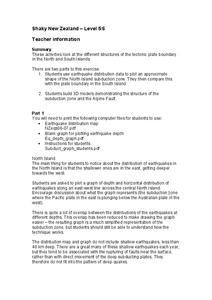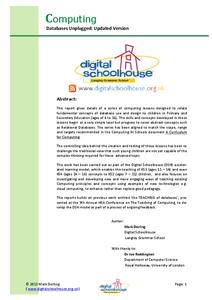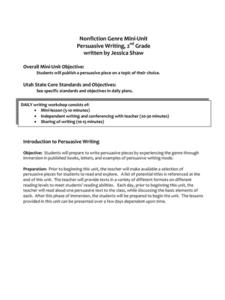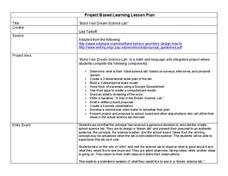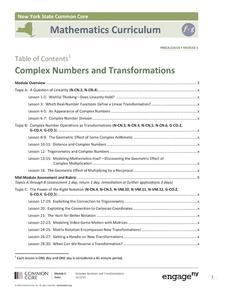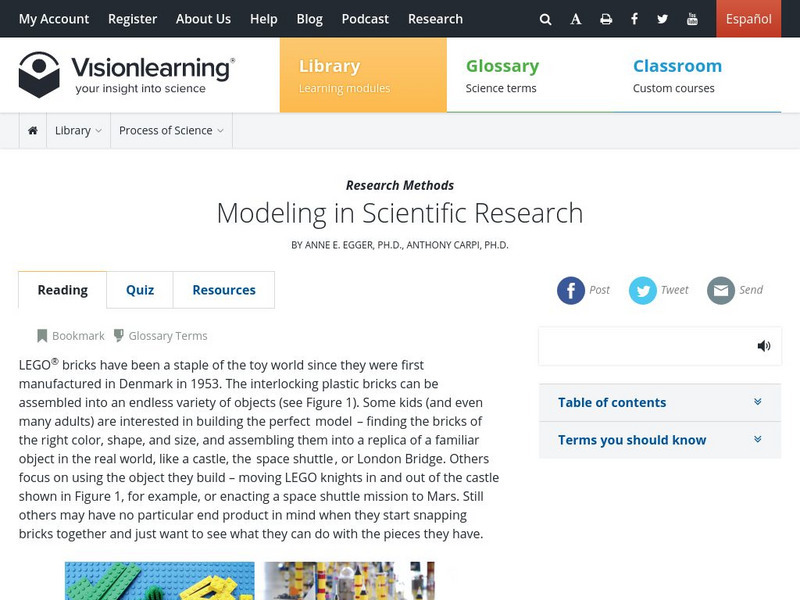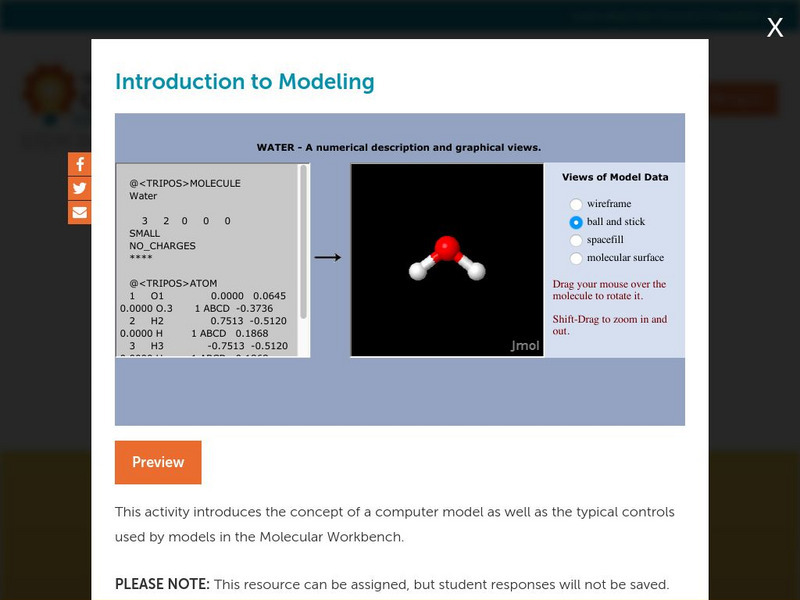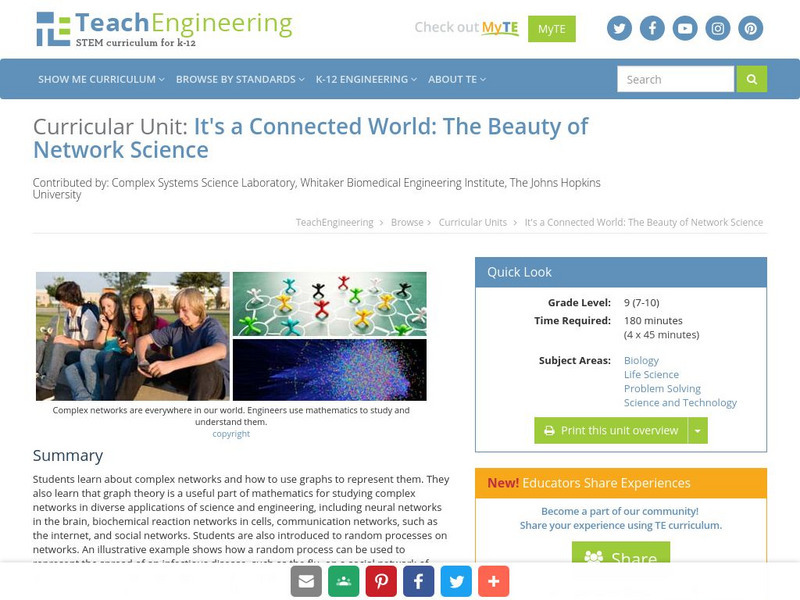Microsoft
Microsoft Computer Applications
From creating and editing workbooks in Microsoft Excel to designing presentations using Microsoft PowerPoint and documents in Microsoft Word, this is your one-stop, must-have resource for lessons on Microsoft Office (2010).
Mathematics Vision Project
Module 8: Modeling Data
Statistics come front and center in this unit all about analyzing discrete data. Real-world situations yield data sets that the class then uses to tease out connections and conclusions. Beginning with the basic histogram and...
Curated OER
Shaky New Zealand
Students explore Earth science by building a model in class. In this tectonic plate lesson, students identify the impact tectonic shifts have on humans and animals and where the plates and faults lie under New Zealand. Students examine...
Computer Science Unplugged
Computing: Databases Unplugged
How do databases store and retrieve information? The activities in the resource provide fundamental concepts of databases by introducing an approach that teaches the basics without using computers. The pupils act as the actual data...
NASA
Future Temperature Projections
No one knows what the future will bring, but it's likely to be warmer than before. Pupils first learn about the NASA GISS ModelE2, a global climate model, and about representative concentration pathways that estimate the global output of...
Curated OER
Nonfiction Genre Mini-Unit: Persuasive Writing
Should primary graders have their own computers? Should animals be kept in captivity? Young writers learn how to develop and support a claim in this short unit on persuasive writing.
Columbus City Schools
The Mystery of Earth’s History
Every living creature can leave a fossil record, yet most fossils belong to extinct organisms rather than ones currently living. Scholars learn about dating rock layers, fossils, and the environment of the past. Pupils understand that...
Curated OER
Build Your Dream Science Lab
Would your ideal science lab be filled with bubbling beakers and zapping Tesla coils? Or would it contain state-of-the-art computer technology and data analysis? Dream big with an innovative lesson that connects math and language...
Council for the Curriculum, Examinations and Assessment
Managing Influences and Making Decisions
Internal and external factors influence behavior and decision making. The third session in a 10-lesson series focusing on Social, Physical, Emotional, Cognitive and Spiritual (SPECS) health explores the impact of these factors...
Buffalo State
A Five Day Approach to Using Technology and Manipulatives to Explore Area and Perimeter
Young mathematicians build an understanding of area and perimeter with their own two hands in a series of interactive geometry lessons. Through the use of different math manipulatives, children investigate the properties of...
EngageNY
Polynomial, Rational, and Radical Relationships
This assessment pair goes way beyond simple graphing, factoring and solving polynomial equations, really forcing learners to investigate the math ideas behind the calculations. Short and to-the-point questions build on one another,...
EngageNY
Complex Numbers and Transformations
Your learners combine their knowledge of real and imaginary numbers and matrices in an activity containing thirty lessons, two assessments (mid-module and end module), and their corresponding rubrics. Centered on complex numbers and...
Curated OER
Deciphering Word Problems in Order to Write Equations
Help young mathematicians crack the code of word problems with this three-lesson series on problem solving. Walking students step-by-step through the process of identifying key information, creating algebraic equations, and finally...
Vision Learning
Visionlearning: Research Methods: Modeling in Scientific Research
Explanation of how physical and conceptual models can be used during scientific research. Several examples are given ranging from modeling with Legos to computer modeling.
Concord Consortium
Concord Consortium: Introduction to Modeling
This activity introduces the concept of a computer model as well as the typical controls used by models in the Molecular Workbench. (Requires Java)
Khan Academy
Khan Academy: Modeling Gravity and Friction
Application of Newton's Law of force and gravity to computer graphic programming.
University of Arizona
University of Arizona: Using Computers to Study Molecular Structure
The main objective for this exercise is to enhance your study of the properties and structures of biological molecules with modern computer graphics. Rather than passively viewing illustrations of molecular structure as they occur in...
TeachEngineering
Teach Engineering: Teaching the Engineering Design Process
Students follow the steps of the engineering design process (EDP) while learning about assistive devices and biomedical engineering. They first go through a design-build-test activity to learn the steps of the cyclical engineering design...
TeachEngineering
Teach Engineering: It's a Connected World: The Beauty of Network Science
Students learn about complex networks and how to use graphs to represent them. They also learn that graph theory is a useful part of mathematics for studying complex networks in diverse applications of science and engineering, including...
Princeton University
Model of the Hagia Sophia
This page contains a description of the Hagia Sophia along with pictures & a computer drafted model of the structure.
Concord Consortium
Concord Consortium: Quantum Tunneling
Delve into a microscopic world working with models that show how electron waves can tunnel through certain types of barriers. Learn about the novel devices and apparatuses that have been invented using this concept. Discover how...
Concord Consortium
The Concord Consortium: What Are Some Patterns in How Things Stick Together or Push Apart?
In this learning module from The Concord Consortium, students will start to develop their own computer simulation models of how attraction and repulsion between charged objects work.
Goodwill
Gcf Global: Smartphone Buying Guide
Whether you're thinking about purchasing your first smartphone or just upgrading from an older model, you might feel overwhelmed shopping for a new smartphone. With so many options to choose from, it's difficult to know if you're getting...
Khan Academy
Khan Academy: Markov Chains
The concept of modeling sequences of random events using states and transitions between states became to known as Markov Chains. Introduction to Markov chains. Created by Brit Cruise.


